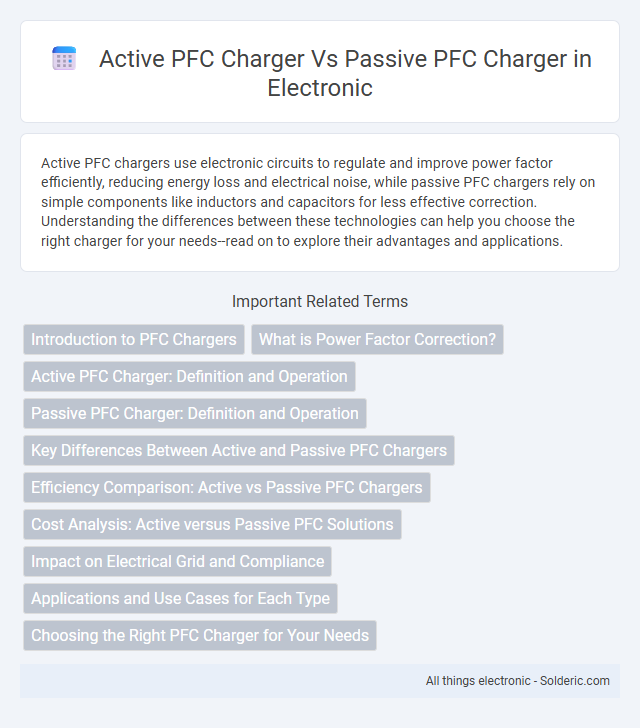Active PFC chargers use electronic circuits to regulate and improve power factor efficiently, reducing energy loss and electrical noise, while passive PFC chargers rely on simple components like inductors and capacitors for less effective correction. Understanding the differences between these technologies can help you choose the right charger for your needs--read on to explore their advantages and applications.
Comparison Table
| Feature | Active PFC Charger | Passive PFC Charger |
|---|---|---|
| Power Factor | 0.9 to 0.99 (High) | 0.6 to 0.7 (Low) |
| Efficiency | 85% to 95% | 70% to 80% |
| Harmonic Distortion | Low harmonic distortion | High harmonic distortion |
| Cost | Higher initial cost | Lower initial cost |
| Size and Weight | More complex and larger | Simple and compact |
| Heat Generation | Lower heat generation | Higher heat generation |
| Applications | High-performance electronics, power supplies | Basic chargers, low-budget applications |
Introduction to PFC Chargers
Active PFC chargers use electronic circuits to improve the power factor by actively shaping the input current waveform, resulting in higher efficiency and lower harmonic distortion compared to passive PFC chargers. Passive PFC chargers rely on simple components like inductors and capacitors to passively correct the power factor but typically offer lower correction levels and increased energy loss. Selecting the right PFC charger ensures your device operates more efficiently while reducing electrical noise and energy consumption.
What is Power Factor Correction?
Power Factor Correction (PFC) improves the efficiency of electrical power usage by reducing reactive power and harmonics in AC power systems. Active PFC chargers use electronic circuits to dynamically adjust and maintain a near-unity power factor, delivering cleaner power and reducing electricity costs. Your choice between Active and Passive PFC chargers impacts energy efficiency, with Passive PFC relying on simple components like inductors to mitigate but not optimize power factor correction.
Active PFC Charger: Definition and Operation
An Active PFC (Power Factor Correction) charger uses electronic circuits, such as boost converters, to continuously regulate and improve the power factor by shaping the input current to be in phase with the voltage. This operation reduces harmonic distortion and enhances energy efficiency, leading to lower electricity costs and compliance with stringent regulatory standards. You benefit from a more stable power supply and reduced electromagnetic interference when using an Active PFC charger compared to a Passive PFC charger.
Passive PFC Charger: Definition and Operation
Passive PFC chargers utilize simple inductors and capacitors to reduce harmonic distortion in power supply, improving efficiency by shaping the input current waveform without active electronic control. These chargers operate with lower complexity and cost, but provide less precise power factor correction compared to active PFC systems. Passive PFC is commonly found in lower-end power supplies where basic compliance with power quality standards is sufficient.
Key Differences Between Active and Passive PFC Chargers
Active PFC chargers utilize electronic circuits to dynamically correct power factor, achieving values typically above 0.9, which reduces energy losses and improves efficiency. Passive PFC chargers rely on fixed passive components like inductors and capacitors, resulting in lower efficiency and power factor values around 0.7 to 0.8. The key differences include active PFC's ability to adapt to varying load conditions versus passive PFC's static correction, leading to superior harmonic reduction and compliance with energy regulations in active PFC chargers.
Efficiency Comparison: Active vs Passive PFC Chargers
Active PFC chargers typically achieve efficiency rates of 90% or higher by continuously regulating input current and maintaining a near-unity power factor, reducing energy losses and harmonics. Passive PFC chargers generally exhibit lower efficiency, around 75-85%, due to their reliance on passive components like inductors and capacitors that cannot dynamically correct power factor variations. The enhanced efficiency of active PFC chargers results in lower electricity consumption, reduced heat generation, and compliance with stricter regulatory standards for power quality.
Cost Analysis: Active versus Passive PFC Solutions
Active PFC chargers generally have a higher initial cost due to the complexity of components and circuitry compared to Passive PFC chargers. However, Active PFC solutions offer improved energy efficiency and lower harmonic distortion, potentially reducing electricity bills and compliance costs over time. Your choice between Active and Passive PFC should balance upfront expenditure against long-term operational savings and regulatory requirements.
Impact on Electrical Grid and Compliance
Active PFC chargers improve power factor by dynamically correcting power usage, reducing harmonic distortion and enhancing overall grid efficiency. Passive PFC chargers rely on fixed components, leading to lower efficiency and potential regulatory non-compliance in regions with strict power quality standards. Your choice of an Active PFC charger supports better compliance with international standards such as IEC 61000-3-2, promoting a more stable and sustainable electrical grid.
Applications and Use Cases for Each Type
Active PFC chargers are commonly used in high-performance electronics, gaming PCs, and servers due to their superior efficiency and reduced harmonic distortion, which ensures stable power delivery in demanding applications. Passive PFC chargers find applications in cost-sensitive consumer electronics and basic power supplies where efficiency and compliance standards are less critical but simplicity and lower production cost matter. If your device requires energy-efficient power conversion and compliance with stringent regulatory standards, an active PFC charger is the preferred choice.
Choosing the Right PFC Charger for Your Needs
Active PFC chargers provide higher efficiency and better power factor correction, making them ideal for energy-saving applications and environments with strict regulatory compliance. Passive PFC chargers offer simpler design and lower cost but may result in lower power efficiency and increased harmonic distortion. Selecting the right PFC charger depends on balancing budget constraints, energy efficiency goals, and the specific power quality requirements of your devices.
Active PFC charger vs Passive PFC charger Infographic

 solderic.com
solderic.com